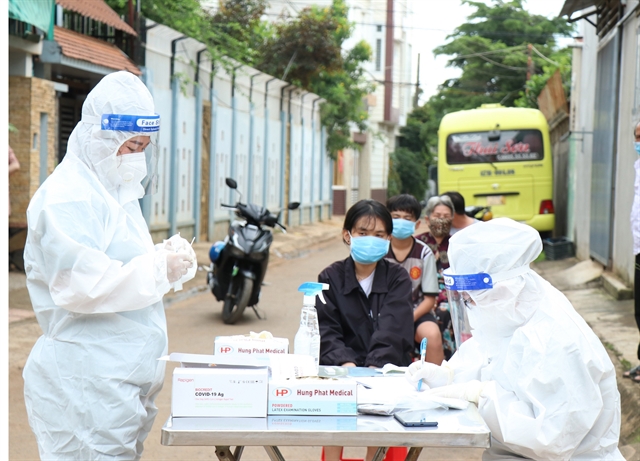
However, the number of people travelling from pandemic-affected areas to other localities increased after social distancing measures were eased.
Minister of Health Nguyễn Thanh Long urged localities to raise their vigilance as the risk of further COVID-19 outbreaks is very high in the near future.
 |
| Residents in Buôn Ma Thuột City are tested for COVID-19 after 98 community infection cases were detected on Sunday. — VNA/VNS Photo Tuấn Anh |
Localities are told to implement drastic measures to prevent a new wave of COVID-19 infections.
Speaking at an online conference on Resolution 128, which provides temporary guidance on safe adaptation, flexibility and effective control of the pandemic on Sunday, Long said the pandemic has been basically put under control in key areas in HCM City and neighbouring Bình Dương, Long An, and Đồng Nai provinces.
However, the number of people travelling from pandemic-affected areas to other localities increased after social distancing measures were eased.
New clusters have appeared with the infection source mainly from people returning from pandemic-hit areas. Phú Thọ, Thanh Hóa, Nam Định and some localities in the southwest region have recorded many community infection cases in this way.
“We express concern about the very high risk of new COVID-19 outbreaks in the near future. Localities must raise their vigilance to avoid new COVID-19 waves," he said.
Long asked localities to tighten control over people returning from HCM City, Long An, Bình Dương and Đồng Nai and implement appropriate preventive measures such as testing and quarantining as regulated to maintain anti-pandemic achievements.
Regarding the implementation of the Government’s Resolution 128 and the ministry’s Decision 4800, many cities and provinces have flexibly and safely adapted to the 'new normal'. Many localities raised opinions about quarantine and vaccination against COVID-19, proper treatment for patients as well as other issues on goods distribution and travel.
Long said the localities need to contact the ministry if they had difficulties in implementing the guidelines, stressing that the most important was to control the pandemic to avoid a new COVID-19 wave.
He said vaccine coverage was one of the criteria for classifying pandemic levels, including low, medium, high and very high risk.
The ministry targeted to reach vaccine coverage of the second dose for at least 80 per cent of people over 65 years old in October and reach the same coverage for people over 50 years old in November.
Long urged localities that have been allocated vaccines to speed up vaccinations and update vaccine records on e-health applications.
He suggested localities look at the situation of COVID-19 and vaccine supply to organise vaccinations for children aged between 12-17 according to the roadmap of the ministry.
The ministry has sent guidelines issued on October 14 on vaccination against COVID-19 for children between 12-17 years old to leaders of the cities and provinces nationwide.
The second criteria, he said, was adequate medical facilities, especially the treatment system, hospital beds and ventilators for the worst-case scenario to minimise the number of deaths. Medical staff must be trained to handle unexpected situations.
Localities that fail to meet those criteria must level up their pandemic risk, he added.
Regarding the assessment of the pandemic level, Long said the pandemic risk assessment should be carried out on the smallest scale in communes or wards. Travelling and transportation of goods must be maintained at all levels, but people must comply with 5K preventive measures.
Regarding COVID-19 testing, Long suggested localities strictly follow the instructions of the ministry to include 20 testing samples, including PCR, to reduce the cost of testing.
Hospitals and health clinics should only test people with symptoms. Patients would not be charged for the testing as it would be allocated from the health insurance or the state budget.
Regarding quarantine regulations, he noted that localities needed to lock down on a small scale, such as a few houses in an alley or a small area in a commune or ward, to control the outbreak and maintain people's lives and socio-economic development.
(Source:VNS)





